

How To Convert An Old Washing Machine Into A Water-Powered Generator. 20 המצאות עירוניות גאוניות שחייבות להיות מותקנות בכל עיר בארץ. יש כמה ערים ברחבי העולם, כך מסתבר, בהן העירייה מפנה חלק מהזמן שלה כדי לפעול למען התושבים במקום לחלק להם דוחות חניה ולגבות מהם ארנונה שערורייתית.
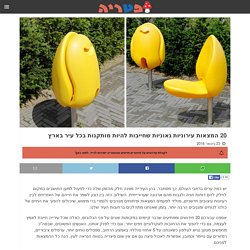
השילוב הזה בין רצון לשפר את חייהם של האזרחים לבין רעיונות עיצובים חדשניים, מוליד לפעמים המצאות ופיתוחים מגניבים ולגמרי ברי מימוש, שיכולים להפוך את החיים של כולנו לנוחים ומגניבים הרבה יותר, בזמן שאנחנו מתהלכים ברחובות העיר שלנו. אספנו עבורכם 20 חידושים ומפתיעים שכבר קיימים במקומות שונים על פני הגלובוס, כאלה שכל עירייה חייבת לאמץ לעצמה, גם כדי להפוך את הרחובות לאקולוגיים ויפים יותר, וגם כדי לפנק אותנו, האנשים הפשוטים, שבסה"כ מחפשים מטען נגיש לטלפון כשאנחנו על 5 אחוזי סוללה באמצע הרחוב, ספסלים נוחים יותר, ערסלים ציבוריים, רמזורים עם טיימר וכמובן, אפשרות לאכול פיצה גם אם אין שום פיצריה בטווח הנראה לעין.
הנה כל ההמצאות לפניכם. StoreDot Charges Up With $42M For Its Fast-Charging Bio-Organic Batteries. Israeli startup StoreDot, which is developing quantum dot-utilizing fast-charging smartphone battery technology, among other things, has closed a $42 million Series B funding round.
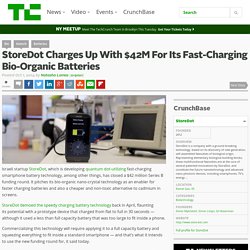
It pitches its bio-organic nano-crystal technology as an enabler for faster charging batteries and also a cheaper and non-toxic alternative to cadmium in screens. StoreDot demoed the speedy charging battery technology back in April, flaunting its potential with a prototype device that charged from flat to full in 30 seconds — although it used a less than full capacity battery that was too large to fit inside a phone. Commercializing this technology will require applying it to a full capacity battery and squeezing everything to fit inside a standard smartphone — and that’s what it intends to use the new funding round for, it said today. StoreDot raises $18M to help build instant-charging batteries for electric cars. StoreDot, an Israeli startup that makes ultra-fast charging batteries using bio-organic technology, has raised $18 million to help fund a new electric vehicle business unit.
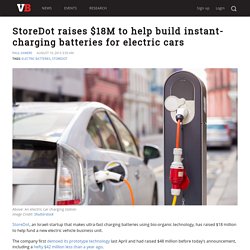
Gogoro Smartscooter counts on a network of battery-swap stations to stay on the move. Electric two-wheelers seem to be the weapon of choice for big-thinking entrepreneurs looking to keep urban centers of the future on the move.

One major design focus, whether they be folded up and thrown in the car or squeezed inside your backpack, has been maximizing the distance the vehicles can travel before they need plugging in for a recharge. But if the plans of Taiwanese firm Gogoro do materialize, then the range of these bikes and scooters may not matter so much after all. The company rolled up to this week's CES to showcase its Smartscooter, which it says will one day move around smart cities swapping out batteries at vending machines as it runs out of juice. The Gogoro Smartscooter cannot be recharged via an outlet. Its battery, which uses Panasonic's 18650-size automotive-grade lithium-ion energy cells, near field communication (NFC) and 256-bit encryption, forms part of a modular battery exchange network the company hopes will span the megacities of tomorrow.
Source: Gogoro. Nansulate-Paint on Insulation. Clear thermal insulation and mold prevention coating, insulates and reduces energy use in an easy to apply, environmentally friendly coating.

This 21st century technology reduces energy consumption, for significant cost savings with long-term performance. Applications: The product is designed to increase the thermal resistance of walls, ceilings, and attics and provide resistance to mold growth. Ikea’s New Wireless Charging Furniture Series. Always keen to keep up with the times, Ikea have just unveiled a new series of furniture and accessories which incorporate wireless charging pads for our smartphones.

The charging pads comply with the Qi inductive power protocol which looks set to become the industry standard in this rapidly growing field. The technology is set to become incorporated more and more in our daily lives as newer devices begin to include it. Ikea’s wireless charging spots are defined by a slightly raised grey plus sign — an appropriate symbol indicating both ‘X marks the spot’, and of course signalling the oncoming addition of electrical charge. Flyte Levitating Wireless Light Bulb. It has often been observed throughout history that what is at one time seen as magic later turns out to have more scientific foundations.
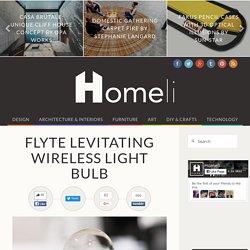
If Flyte had been unveiled 500 years ago Simon Morris might have been burnt at the stake, but hopefully the world is ready for levitating light bulbs. There is something delightfully absurd about Flyte, in the same sense as some of the bizarre concepts in Douglas Adam’s ‘The Hitchhiker’s Guide to the Galaxy’, pushing the evolution of a piece of technology to its illogical conclusion. Embedded within the wooden base of Flyte is a series of electromagnets which are capable of levitating the lightbulb in a steady state. In the event of a power-cut the magnets will stop working, but the lightbulb should land safely on the pad, and also features a shatterproof shell just incase.
OLED. Prototype OLED lighting panels Demonstration of a flexible OLED device.
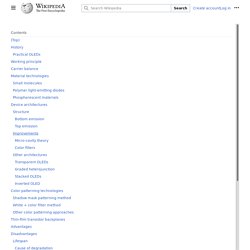
Meet Curb! The smartest way to control energy use. Curb featured on TV after hitting goal on Indiegogo! Curb. Curb - Power Your Life. Smarter. Powercom - Electricity Meters.